My
List |
Addition Date
|
Target
|
Mission
|
Instrument
|
Size
|

|
1996-09-13 |
Sol (our sun)
|
Voyager
|
VG ISS - Wide Angle
|
3430x2650x3 |

|
-
PIA00450:
-
Solar System Portrait - View of the Sun, Earth and Venus
Full Resolution:
TIFF
(8.676 MB)
JPEG
(515.8 kB)
|

|
1996-09-13 |
Sol (our sun)
|
Voyager
|
VG ISS - Wide Angle
|
4000x1200x3 |

|
-
PIA00451:
-
Solar System Portrait - 60 Frame Mosaic
Full Resolution:
TIFF
(1.124 MB)
JPEG
(166.4 kB)
|

|
2001-02-17 |
Sol (our sun)
|
SOHO
|
Extreme Ultraviolet Imaging Telescope
|
2100x2034x3 |

|
-
PIA03149:
-
Handle-shaped Prominence
Full Resolution:
TIFF
(4.315 MB)
JPEG
(409.1 kB)
|

|
2001-02-17 |
Sol (our sun)
|
SOHO
|
Extreme Ultraviolet Imaging Telescope
|
1067x1067x3 |

|
-
PIA03150:
-
Color Composite of Solar Features
Full Resolution:
TIFF
(3.508 MB)
JPEG
(108.6 kB)
|

|
2003-12-12 |
Sol (our sun)
|
Voyager
|
|
576x389x3 |

|
-
PIA04927:
-
Voyager Approaches Final Frontier (Artist's Concept)
Full Resolution:
TIFF
(598.8 kB)
JPEG
(25.05 kB)
|

|
2004-01-10 |
Sol (our sun)
|
Mars Exploration Rover (MER)
|
Panoramic Camera
|
1600x1200x1 |

|
-
PIA05041:
-
Martian Sunsets More Than Just Pretty
Full Resolution:
TIFF
(188.5 kB)
JPEG
(68.7 kB)
|

|
2004-03-08 |
Sol (our sun)
|
Mars Exploration Rover (MER)
|
Panoramic Camera
|
399x198x3 |

|
-
PIA05518:
-
Martian Eclipses: Deimos and Phobos
Full Resolution:
TIFF
(44.62 kB)
JPEG
(10.21 kB)
|

|
2004-03-12 |
Sol (our sun)
|
Mars Exploration Rover (MER)
|
Panoramic Camera
|
360x360x5 |

|
-
PIA05553:
-
Martian Moon Blocks Sun

Full Resolution:
|

|
2004-03-12 |
Sol (our sun)
|
Mars Exploration Rover (MER)
|
Panoramic Camera
|
360x360x5 |

|
-
PIA05556:
-
Deimos Crosses Face of Sun

Full Resolution:
|

|
2004-03-13 |
Sol (our sun)
|
Mars Exploration Rover (MER)
|
Panoramic Camera
|
1080x360x1 |

|
-
PIA05554:
-
Martian Moon Eclipses Sun, in Stages
Full Resolution:
TIFF
(206 kB)
JPEG
(13.92 kB)
|

|
2006-02-15 |
Sol (our sun)
|
SOHO
|
|
2448x2448x3 |

|
-
PIA18170:
-
SOHO Spacecraft (Artist's Concept)
Full Resolution:
TIFF
(17.98 MB)
JPEG
(266.8 kB)
|

|
2007-04-27 |
Sol (our sun)
|
Solar TErrestrial RElations Observatory (STEREO)
|
SECCHI/Extreme Ultraviolet Imaging Telescope
|
1920x1080x3 |

|
-
PIA09320:
-
Full Disk Image of the Sun, March 26, 2007
Full Resolution:
TIFF
(6.23 MB)
JPEG
(110.4 kB)
|

|
2007-04-27 |
Sol (our sun)
|
Solar TErrestrial RElations Observatory (STEREO)
|
SECCHI/Extreme Ultraviolet Imaging Telescope
|
1920x1080x3 |

|
-
PIA09321:
-
Full Disk Image of the Sun, March 26, 2007 (Anaglyph)
Full Resolution:
TIFF
(6.23 MB)
JPEG
(91.3 kB)
|

|
2007-04-27 |
Sol (our sun)
|
Solar TErrestrial RElations Observatory (STEREO)
|
SECCHI/Extreme Ultraviolet Imaging Telescope
|
1920x1080x3 |
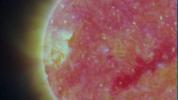
|
-
PIA09322:
-
Close-up View of an Active Region of the Sun, March 23, 2007
Full Resolution:
TIFF
(6.23 MB)
JPEG
(116 kB)
|

|
2007-04-27 |
Sol (our sun)
|
Solar TErrestrial RElations Observatory (STEREO)
|
SECCHI/Extreme Ultraviolet Imaging Telescope
|
1920x1080x3 |

|
-
PIA09323:
-
Close-up View of an Active Region of the Sun, March 23, 2007 (Anaglyph)
Full Resolution:
TIFF
(6.23 MB)
JPEG
(145.6 kB)
|

|
2007-04-27 |
Sol (our sun)
|
Solar TErrestrial RElations Observatory (STEREO)
|
SECCHI/Extreme Ultraviolet Imaging Telescope
|
1920x1080x3 |
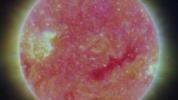
|
-
PIA09324:
-
Closer View of the Equatorial Region of the Sun, March 24, 2007
Full Resolution:
TIFF
(6.23 MB)
JPEG
(129.6 kB)
|

|
2007-04-27 |
Sol (our sun)
|
Solar TErrestrial RElations Observatory (STEREO)
|
SECCHI/Extreme Ultraviolet Imaging Telescope
|
1920x1080x3 |

|
-
PIA09325:
-
Closer View of the Equatorial Region of the Sun, March 24, 2007 (Anaglyph)
Full Resolution:
TIFF
(6.23 MB)
JPEG
(169.6 kB)
|

|
2007-04-27 |
Sol (our sun)
|
Solar TErrestrial RElations Observatory (STEREO)
|
SECCHI/Extreme Ultraviolet Imaging Telescope
|
1920x1080x3 |

|
-
PIA09326:
-
Right Limb of the South Pole of the Sun, March 18, 2007
Full Resolution:
TIFF
(6.23 MB)
JPEG
(85.81 kB)
|

|
2007-04-27 |
Sol (our sun)
|
Solar TErrestrial RElations Observatory (STEREO)
|
SECCHI/Extreme Ultraviolet Imaging Telescope
|
1920x1080x3 |

|
-
PIA09327:
-
Right Limb of the South Pole of the Sun, March 18, 2007 (Anaglyph)
Full Resolution:
TIFF
(6.23 MB)
JPEG
(99.1 kB)
|

|
2007-04-27 |
Sol (our sun)
|
Solar TErrestrial RElations Observatory (STEREO)
|
SECCHI/Extreme Ultraviolet Imaging Telescope
|
1920x1080x3 |

|
-
PIA09328:
-
North Pole of the Sun, March 20, 2007
Full Resolution:
TIFF
(6.23 MB)
JPEG
(94.86 kB)
|

|
2007-04-27 |
Sol (our sun)
|
Solar TErrestrial RElations Observatory (STEREO)
|
SECCHI/Extreme Ultraviolet Imaging Telescope
|
1920x1080x3 |

|
-
PIA09329:
-
North Pole of the Sun, March 20, 2007 (Anaglyph)
Full Resolution:
TIFF
(6.23 MB)
JPEG
(126.2 kB)
|

|
2007-04-27 |
Sol (our sun)
|
Solar TErrestrial RElations Observatory (STEREO)
|
SECCHI/Extreme Ultraviolet Imaging Telescope
|
1920x1080x3 |

|
-
PIA09330:
-
South Pole of the Sun, March 20, 2007
Full Resolution:
TIFF
(6.23 MB)
JPEG
(94.62 kB)
|

|
2007-04-27 |
Sol (our sun)
|
Solar TErrestrial RElations Observatory (STEREO)
|
SECCHI/Extreme Ultraviolet Imaging Telescope
|
1920x1080x3 |

|
-
PIA09331:
-
South Pole of the Sun, March 20, 2007 (Anaglyph)
Full Resolution:
TIFF
(6.23 MB)
JPEG
(114.9 kB)
|

|
2007-04-27 |
Sol (our sun)
|
Solar TErrestrial RElations Observatory (STEREO)
|
SECCHI/Extreme Ultraviolet Imaging Telescope
|
1920x1080x3 |

|
-
PIA09332:
-
Left Limb of North Pole of the Sun, March 20, 2007
Full Resolution:
TIFF
(6.23 MB)
JPEG
(84.33 kB)
|

|
2007-04-27 |
Sol (our sun)
|
Solar TErrestrial RElations Observatory (STEREO)
|
SECCHI/Extreme Ultraviolet Imaging Telescope
|
1920x1080x3 |

|
-
PIA09333:
-
Left Limb of North Pole of the Sun, March 20, 2007 (Anaglyph)
Full Resolution:
TIFF
(6.23 MB)
JPEG
(89.44 kB)
|

|
2009-10-15 |
Sol (our sun)
|
Cassini-Huygens
|
MIMI
|
1280x720x3 |

|
-
PIA12310:
-
The Bubble of Our Solar System

Full Resolution:
TIFF
(2.768 MB)
JPEG
(62.85 kB)
|

|
2009-11-20 |
Sol (our sun)
|
Cassini-Huygens
|
MIMI
|
1163x781x3 |

|
-
PIA12374:
-
Particles from the Heliosphere
Full Resolution:
TIFF
(2.728 MB)
JPEG
(143 kB)
|

|
2010-12-27 |
Sol (our sun)
|
Mars Exploration Rover (MER)
|
Panoramic Camera
|
640x350x3 |

|
-
PIA13736:
-
Sunset Watched by Opportunity, November 2010

Full Resolution:
TIFF
(672.9 kB)
JPEG
(7.169 kB)
|

|
2010-12-27 |
Sol (our sun)
|
Mars Exploration Rover (MER)
|
Panoramic Camera
|
640x350x3 |

|
-
PIA13737:
-
Phobos Passes in Front of Sun's Face, Nov. 9, 2010

Full Resolution:
TIFF
(672.9 kB)
JPEG
(6.111 kB)
|

|
2011-12-16 |
Sol (our sun)
|
Voyager
|
|
1280x720x3 |

|
-
PIA15176:
-
Low-Energy Particles Leaking out of the Solar System (Artist's Concept)
Full Resolution:
TIFF
(2.768 MB)
JPEG
(130.8 kB)
|

|
2011-12-16 |
Sol (our sun)
|
Voyager
|
|
1280x720x3 |

|
-
PIA15177:
-
Energetic Particles from Outside our Solar System Increase (Artist's Concept)
Full Resolution:
TIFF
(2.768 MB)
JPEG
(103.7 kB)
|

|
2011-12-16 |
Sol (our sun)
|
Voyager
|
|
1280x720x3 |

|
-
PIA15178:
-
Magnetic Field Lines Intensifying (Artist's Concept)
Full Resolution:
TIFF
(2.768 MB)
JPEG
(61.26 kB)
|

|
2011-12-16 |
Sol (our sun)
|
Voyager
|
|
1281x718x3 |

|
-
PIA15179:
-
The Sun's Magnetic Field

Full Resolution:
TIFF
(2.762 MB)
JPEG
(76.94 kB)
|

|
2012-08-31 |
Sol (our sun)
|
SDO
|
Atmosphere Imaging Assembly
|
691x720x3 |

|
-
PIA18167:
-
Magnificent Outburst

Full Resolution:
TIFF
(1.493 MB)
JPEG
(66.48 kB)
|

|
2012-12-03 |
Sol (our sun)
|
Voyager
|
Magnetometer
|
2006x1479x3 |

|
-
PIA16482:
-
The Sun's Southern Wind Flows Northward (Artist's Concept)
Full Resolution:
TIFF
(8.904 MB)
JPEG
(151.9 kB)
|

|
2012-12-03 |
Sol (our sun)
|
Voyager
|
|
1772x975x3 |

|
-
PIA16483:
-
Plasma Flow Near Voyager 1 (Artist Animation)

Full Resolution:
TIFF
(1.731 MB)
JPEG
(117.8 kB)
|

|
2012-12-03 |
Sol (our sun)
|
Voyager
|
|
1000x973x3 |

|
-
PIA16485:
-
Solar and Interstellar Magnetic Fields (Artist's Concept)
Full Resolution:
TIFF
(2.92 MB)
JPEG
(98.65 kB)
|

|
2012-12-03 |
Sol (our sun)
|
Voyager
|
|
1280x720x3 |

|
-
PIA16486:
-
Voyager 1 Explores the "Magnetic Highway"

Full Resolution:
TIFF
(2.766 MB)
JPEG
(61.38 kB)
|

|
2013-02-12 |
Sol (our sun)
|
Voyager
|
|
1280x730x3 |
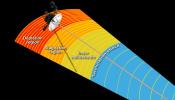
|
-
PIA16734:
-
Magnetic Field Line Pile-Up (Artist's Concept)
Full Resolution:
TIFF
(2.804 MB)
JPEG
(85 kB)
|

|
2013-06-27 |
Sol (our sun)
|
Voyager
|
|
1385x1103x3 |

|
-
PIA17033:
-
Voyagers in the Heliosheath (Cropped)
Full Resolution:
TIFF
(4.585 MB)
JPEG
(80.83 kB)
|

|
2013-06-27 |
Sol (our sun)
|
Voyager
|
|
1280x730x3 |

|
-
PIA17034:
-
Transitional Regions at the Heliosphere's Outer Limits
Full Resolution:
TIFF
(2.804 MB)
JPEG
(110 kB)
|

|
2013-09-12 |
Sol (our sun)
|
Voyager
|
Plasma Wave Instrument
|
1280x720x3 |

|
-
PIA17045:
-
Voyager Captures Sounds of Interstellar Space

Full Resolution:
TIFF
(2.766 MB)
JPEG
(56.6 kB)
|

|
2013-09-12 |
Sol (our sun)
|
Voyager
|
|
5432x3025x3 |
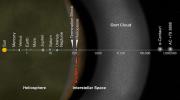
|
-
PIA17046:
-
Voyager Goes Interstellar (Artist Concept)
Full Resolution:
TIFF
(49.32 MB)
JPEG
(3.534 MB)
|

|
2013-09-12 |
Sol (our sun)
|
Voyager
|
Very Long Baseline Array
|
512x512x3 |

|
-
PIA17047:
-
Voyager Signal Spotted By Earth Radio Telescopes
Full Resolution:
TIFF
(264.2 kB)
JPEG
(4.896 kB)
|

|
2013-09-12 |
Sol (our sun)
|
Voyager
|
|
1280x720x3 |
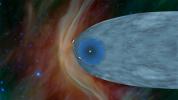
|
-
PIA17048:
-
One Voyager Out, One Voyager In (Artist Concept)
Full Resolution:
TIFF
(2.766 MB)
JPEG
(65.1 kB)
|

|
2013-09-12 |
Sol (our sun)
|
Voyager
|
|
1280x720x3 |

|
-
PIA17049:
-
Voyager in Space (Artist Concept)
Full Resolution:
TIFF
(2.766 MB)
JPEG
(35.7 kB)
|

|
2013-09-12 |
Sol (our sun)
|
Voyager
|
|
1280x720x3 |

|
-
PIA17441:
-
Observed Change in Density Shows Voyager is in Interstellar Space
Full Resolution:
TIFF
(2.766 MB)
JPEG
(44.37 kB)
|

|
2013-09-12 |
Sol (our sun)
|
Voyager
|
|
1280x720x3 |

|
-
PIA17442:
-
Mystery of the Interstellar Magnetic Field (Artist's Concept)
Full Resolution:
TIFF
(2.766 MB)
JPEG
(78.79 kB)
|

|
2013-09-12 |
Sol (our sun)
|
Voyager
|
|
1280x720x3 |

|
-
PIA17460:
-
Moving into Interstellar Space (Artist Concept)
Full Resolution:
TIFF
(2.766 MB)
JPEG
(120.1 kB)
|

|
2013-09-12 |
Sol (our sun)
|
Voyager
|
Oschin Schmidt Telescope
|
891x893x1 |

|
-
PIA17461:
-
Heading toward Gliese 445
Full Resolution:
TIFF
(796.7 kB)
JPEG
(105.7 kB)
|

|
2013-09-12 |
Sol (our sun)
|
Voyager
|
|
8192x4610x3 |

|
-
PIA17462:
-
Voyager 1 Entering Interstellar Space (Artist Concept)
Full Resolution:
TIFF
(113.3 MB)
JPEG
(938.1 kB)
|

|
2013-09-12 |
Sol (our sun)
|
Voyager
|
|
1280x720x3 |

|
-
PIA17463:
-
Heliosphere Traveling Through Interstellar Space
Full Resolution:
TIFF
(2.766 MB)
JPEG
(72.59 kB)
|

|
2014-02-11 |
Sol (our sun)
|
SDO
|
Atmosphere Imaging Assembly
|
1024x1024x3 |

|
-
PIA17669:
-
Pulses from the Sun
Full Resolution:
TIFF
(3.147 MB)
JPEG
(71.34 kB)
|

|
2014-12-22 |
Sol (our sun)
|
NuSTAR
|
NuSTAR
SDO
|
3150x1600x3 |
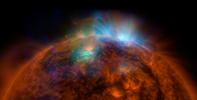
|
-
PIA18906:
-
Sun Shines in High-Energy X-rays
Full Resolution:
TIFF
(15.13 MB)
JPEG
(282 kB)
|

|
2015-01-29 |
Sol (our sun)
|
SDO
|
Atmosphere Imaging Assembly
|
792x792x3 |

|
-
PIA17914:
-
Substantial Coronal Hole
Full Resolution:
TIFF
(1.883 MB)
JPEG
(66.47 kB)
|

|
2015-04-03 |
Sol (our sun)
|
SDO
|
Atmosphere Imaging Assembly
|
792x819x3 |

|
-
PIA17915:
-
Two Coronal Holes

Full Resolution:
TIFF
(1.46 MB)
JPEG
(52.39 kB)
|

|
2015-06-30 |
Sol (our sun)
|
SDO
|
Atmosphere Imaging Assembly
|
720x720x3 |

|
-
PIA18210:
-
Plasma Push and Pull

Full Resolution:
TIFF
(1.272 MB)
JPEG
(34.16 kB)
|

|
2015-07-08 |
Sol (our sun)
|
NuSTAR
|
NuSTAR
SDO
|
4096x4096x3 |

|
-
PIA19821:
-
NuSTAR Stares at the Sun
Full Resolution:
TIFF
(50.35 MB)
JPEG
(797.3 kB)
|

|
2015-07-10 |
Sol (our sun)
|
SDO
|
Atmosphere Imaging Assembly
|
1024x1024x3 |

|
-
PIA19680:
-
Solar Activity Seen at Sunspot Site Tracked by Mars Rover
Full Resolution:
TIFF
(3.147 MB)
JPEG
(117.4 kB)
|

|
2015-07-10 |
Sol (our sun)
|
Mars Science Laboratory (MSL)
|
Mastcam
|
801x400x1 |

|
-
PIA19801:
-
Tracking Sunspots from Mars, Summer 2015 (Animation)

Full Resolution:
TIFF
(320.9 kB)
JPEG
(22.27 kB)
|

|
2015-07-10 |
Sol (our sun)
|
Mars Science Laboratory (MSL)
|
Mastcam
|
801x400x1 |

|
-
PIA19802:
-
Tracking Sunspots from Mars, April 2015 (Animation)

Full Resolution:
TIFF
(320.9 kB)
JPEG
(25.3 kB)
|

|
2015-08-06 |
Sol (our sun)
|
SDO
|
Atmosphere Imaging Assembly
|
720x720x3 |

|
-
PIA19874:
-
A Golden Arch

Full Resolution:
TIFF
(1.374 MB)
JPEG
(54.66 kB)
|

|
2015-08-19 |
Sol (our sun)
|
SDO
|
Atmosphere Imaging Assembly
|
720x720x3 |

|
-
PIA19875:
-
Eiffel Tower Plume

Full Resolution:
TIFF
(1.194 MB)
JPEG
(53.77 kB)
|

|
2015-08-26 |
Sol (our sun)
|
SDO
|
Atmosphere Imaging Assembly
|
792x792x3 |

|
-
PIA19876:
-
Big Sunspot Group

Full Resolution:
TIFF
(1.028 MB)
JPEG
(58.74 kB)
|

|
2015-09-02 |
Sol (our sun)
|
SDO
|
Atmosphere Imaging Assembly
|
720x720x3 |
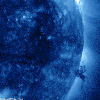
|
-
PIA19878:
-
Tangled up in Blue

Full Resolution:
TIFF
(1.556 MB)
JPEG
(84.17 kB)
|

|
2015-09-10 |
Sol (our sun)
|
SDO
|
Atmosphere Imaging Assembly
|
720x720x3 |

|
-
PIA19950:
-
A Triumvirate: Three Coronal Holes

Full Resolution:
TIFF
(1.195 MB)
JPEG
(44.65 kB)
|

|
2015-09-13 |
Sol (our sun)
|
SDO
|
Atmosphere Imaging Assembly
|
4096x4096x3 |

|
-
PIA19949:
-
SDO Transit, September 2015

Full Resolution:
TIFF
(19.58 MB)
JPEG
(918.5 kB)
|

|
2015-10-13 |
Sol (our sun)
|
SDO
|
Atmosphere Imaging Assembly
|
720x720x3 |

|
-
PIA20008:
-
Hefty Prominence Eruption

Full Resolution:
TIFF
(1.164 MB)
JPEG
(53.28 kB)
|

|
2015-10-28 |
Sol (our sun)
|
SDO
|
Atmosphere Imaging Assembly
|
720x720x3 |

|
-
PIA20048:
-
Active Regions Blossoming

Full Resolution:
TIFF
(1.494 MB)
JPEG
(61.29 kB)
|

|
2015-12-12 |
Sol (our sun)
|
SDO
|
Atmosphere Imaging Assembly
|
864x486x3 |
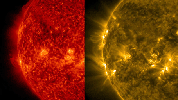
|
-
PIA20214:
-
Comparing Wavelengths

Full Resolution:
TIFF
(1.234 MB)
JPEG
(55.75 kB)
|

|
2016-02-09 |
Sol (our sun)
|
SDO
|
Atmosphere Imaging Assembly
|
768x576x3 |

|
-
PIA20474:
-
Solar Triumvirate

Full Resolution:
TIFF
(1.309 MB)
JPEG
(56.46 kB)
|

|
2016-03-24 |
Sol (our sun)
|
SDO
|
Atmosphere Imaging Assembly
|
720x543x3 |
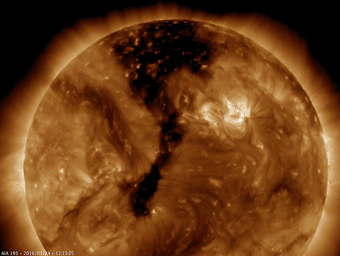
|
-
PIA19178:
-
Elongated Coronal Hole

Full Resolution:
TIFF
(961.2 kB)
JPEG
(37.28 kB)
|

|
2016-04-06 |
Sol (our sun)
|
SDO
|
Atmosphere Imaging Assembly
|
720x719x3 |

|
-
PIA20604:
-
Towering Arches

Full Resolution:
TIFF
(1.366 MB)
JPEG
(57.27 kB)
|

|
2016-05-09 |
Sol (our sun)
|
SDO
|
Atmosphere Imaging Assembly
|
854x480x3 |

|
-
PIA14729:
-
Mercury Transit Across the Sun

Full Resolution:
TIFF
(1.176 MB)
JPEG
(52.22 kB)
|

|
2016-05-18 |
Sol (our sun)
|
SDO
|
Atmosphere Imaging Assembly
|
720x720x3 |
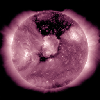
|
-
PIA15379:
-
Coronal Hole Front and Center

Full Resolution:
TIFF
(1.095 MB)
JPEG
(49.07 kB)
|

|
2016-06-08 |
Sol (our sun)
|
SDO
|
Atmosphere Imaging Assembly
|
720x531x3 |

|
-
PIA20739:
-
Twisting Plasma

Full Resolution:
TIFF
(872.2 kB)
JPEG
(42.3 kB)
|

|
2016-06-16 |
Sol (our sun)
|
SDO
|
Atmosphere Imaging Assembly
|
2100x2100x3 |

|
-
PIA20881:
-
Magnetic Field Illuminated
Full Resolution:
TIFF
(12.58 MB)
JPEG
(804.6 kB)
|

|
2016-06-27 |
Sol (our sun)
|
SDO
|
Atmosphere Imaging Assembly
|
720x720x3 |

|
-
PIA20882:
-
Bright Arcing Loops

Full Resolution:
TIFF
(1.403 MB)
JPEG
(50.15 kB)
|

|
2016-07-09 |
Sol (our sun)
|
SDO
|
Atmosphere Imaging Assembly
|
720x720x3 |

|
-
PIA20883:
-
Weak Thrusts

Full Resolution:
TIFF
(1.222 MB)
JPEG
(58.52 kB)
|

|
2016-07-18 |
Sol (our sun)
|
SDO
|
Atmosphere Imaging Assembly
|
720x540x3 |

|
-
PIA17911:
-
Magnetic Coiling

Full Resolution:
TIFF
(1.045 MB)
JPEG
(48.66 kB)
|

|
2016-07-23 |
Sol (our sun)
|
SDO
|
Atmosphere Imaging Assembly
|
720x402x3 |

|
-
PIA17912:
-
Solar Flares with some Flair

Full Resolution:
TIFF
(852.2 kB)
JPEG
(31.3 kB)
|

|
2016-08-13 |
Sol (our sun)
|
SDO
|
Atmosphere Imaging Assembly
|
720x397x3 |

|
-
PIA17913:
-
Playing Along the Edge

Full Resolution:
TIFF
(854 kB)
JPEG
(48.96 kB)
|

|
2016-08-25 |
Sol (our sun)
|
SDO
|
Atmosphere Imaging Assembly
|
720x741x3 |

|
-
PIA21027:
-
Eclipse Season for SDO

Full Resolution:
TIFF
(616 kB)
JPEG
(29.35 kB)
|

|
2016-09-01 |
Sol (our sun)
|
SDO
|
Atmosphere Imaging Assembly
|
720x719x3 |

|
-
PIA21028:
-
Double Eclipse

Full Resolution:
TIFF
(1.045 MB)
JPEG
(56.14 kB)
|

|
2016-09-08 |
Sol (our sun)
|
SDO
|
Atmosphere Imaging Assembly
|
2100x2100x3 |
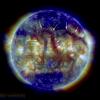
|
-
PIA16996:
-
Two Long Filaments
Full Resolution:
TIFF
(10.02 MB)
JPEG
(313.7 kB)
|

|
2016-09-15 |
Sol (our sun)
|
SDO
|
Atmosphere Imaging Assembly
|
1800x979x3 |

|
-
PIA16997:
-
Varietal Loops

Full Resolution:
TIFF
(3.98 MB)
JPEG
(141.7 kB)
|

|
2016-09-21 |
Sol (our sun)
|
SDO
|
Atmosphere Imaging Assembly
|
1500x1501x3 |

|
-
PIA21067:
-
Earth-Directed Coronal Hole

Full Resolution:
TIFF
(4.12 MB)
JPEG
(131.9 kB)
|

|
2016-09-29 |
Sol (our sun)
|
SDO
|
Atmosphere Imaging Assembly
|
1751x1800x3 |

|
-
PIA21101:
-
Magnetic Field Arches

Full Resolution:
TIFF
(6.935 MB)
JPEG
(188 kB)
|

|
2016-10-04 |
Sol (our sun)
|
SDO
|
Atmosphere Imaging Assembly
|
2400x1331x3 |
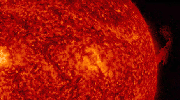
|
-
PIA21106:
-
Bendable Prominence

Full Resolution:
TIFF
(9.203 MB)
JPEG
(470.5 kB)
|

|
2016-10-11 |
Sol (our sun)
|
SDO
|
Atmosphere Imaging Assembly
|
1800x1445x3 |

|
-
PIA21109:
-
Agitated Active Region

Full Resolution:
TIFF
(3.63 MB)
JPEG
(152.3 kB)
|

|
2016-10-21 |
Sol (our sun)
|
SDO
|
Atmosphere Imaging Assembly
|
3300x1854x3 |

|
-
PIA15378:
-
Substantial Coronal Holes

Full Resolution:
TIFF
(8.71 MB)
JPEG
(492.2 kB)
|

|
2016-10-27 |
Sol (our sun)
|
SDO
|
Atmosphere Imaging Assembly
|
1200x1200x3 |

|
-
PIA15377:
-
Wavelength Comparison
Full Resolution:
TIFF
(2.998 MB)
JPEG
(137.2 kB)
|

|
2016-11-04 |
Sol (our sun)
|
SDO
|
Atmosphere Imaging Assembly
|
1487x990x3 |

|
-
PIA21202:
-
Small Surf

Full Resolution:
TIFF
(3.183 MB)
JPEG
(114.7 kB)
|

|
2016-11-09 |
Sol (our sun)
|
SDO
|
Atmosphere Imaging Assembly
|
1200x645x3 |

|
-
PIA16909:
-
Earth-Facing Coronal Holes

Full Resolution:
TIFF
(1.704 MB)
JPEG
(57.05 kB)
|

|
2016-11-30 |
Sol (our sun)
|
SDO
|
Atmosphere Imaging Assembly
|
2025x2025x1 |

|
-
PIA21207:
-
Almost Spotless

Full Resolution:
TIFF
(3.09 MB)
JPEG
(340.3 kB)
|

|
2016-12-06 |
Sol (our sun)
|
SDO
|
Atmosphere Imaging Assembly
|
2400x1350x3 |

|
-
PIA21208:
-
Coronal Hole Coming Around

Full Resolution:
TIFF
(5.501 MB)
JPEG
(216.2 kB)
|

|
2016-12-14 |
Sol (our sun)
|
SDO
|
Atmosphere Imaging Assembly
|
2100x1181x3 |

|
-
PIA15301:
-
Both Sides Now

Full Resolution:
TIFF
(3.383 MB)
JPEG
(354.1 kB)
|

|
2017-01-03 |
Sol (our sun)
|
SDO
|
Atmosphere Imaging Assembly
|
2400x1404x3 |

|
-
PIA15032:
-
Jumpy Active Region

Full Resolution:
TIFF
(5.395 MB)
JPEG
(180.7 kB)
|

|
2017-01-09 |
Sol (our sun)
|
SDO
|
Atmosphere Imaging Assembly
|
-1x-1x3 |

|
-
PIA14093:
-
Lengthy Coronal Hole

Full Resolution:
TIFF
(7.362 MB)
JPEG
(273.3 kB)
|

|
2017-01-17 |
Sol (our sun)
|
SDO
|
Atmosphere Imaging Assembly
|
1500x1500x3 |

|
-
PIA12327:
-
Organized Arches

Full Resolution:
TIFF
(4.328 MB)
JPEG
(135 kB)
|

 Planetary Data System
Planetary Data System



















































































































